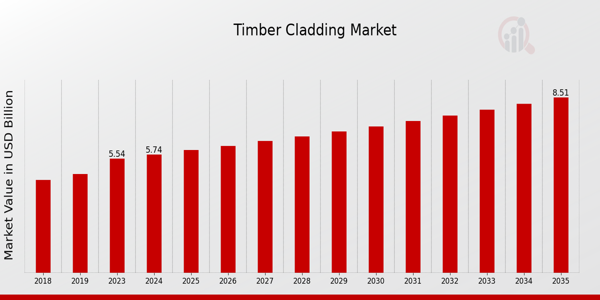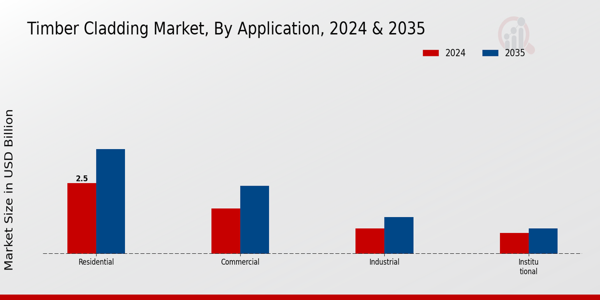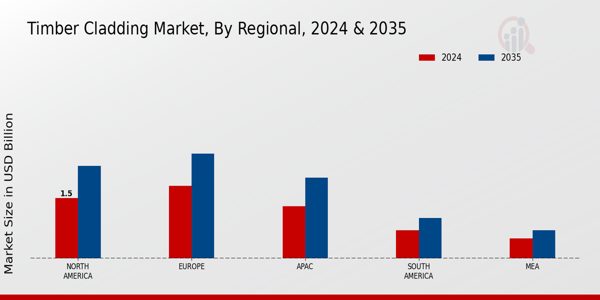Global Timber Cladding Market Overview
As per MRFR analysis, the Timber Cladding Market Size was estimated at 5.54 (USD Billion) in 2023. The Timber Cladding Market Industry is expected to grow from 5.74 (USD Billion) in 2024 to 8.5 (USD Billion) by 2035. The Timber Cladding Market CAGR (growth rate) is expected to be around 3.64% during the forecast period (2025 - 2035).
Key Timber Cladding Market Trends Highlighted
The Timber Cladding Market is experiencing significant growth due to a rising awareness of sustainable building materials and a shift towards eco-friendly construction practices. Increased investment in infrastructure and residential projects fuels the demand for timber cladding, as it offers aesthetic appeal and insulation benefits. The trend towards environmentally-conscious design is a primary market driver, fostering the use of renewable resources while promoting energy efficiency. Furthermore, the durability and natural resilience of timber against various weather conditions make it an attractive choice for builders and architects.The market had a number of unexplored opportunities, which include coming up with advanced industrial processes that will complement the development of the most durable industrial timber and having it upgraded in antifungal treatments, which will, in turn, increase its service life to the environmental factors. The innovations in the manufacturing processes are also potential points for the characteristics of the material's performance, which could create new market segments. Also, the burgeoning markets serve as potential areas for expansion as urbanization increases the need for new technologies in construction, like timber cladding and other modern ones. These trends can be curtailed by the stakeholders by the use of multiple species or finishes to appeal to varied customers. Imitation cladding using timber has gained popularity recently in architecture, which combines traditional forms with contemporary needs and looks.
This trend is supported by a growing inclination towards natural materials that create a warm ambiance while ensuring structural performance. As sustainability continues to advance as a priority in construction, advancements in timber production and implementation techniques are likely to shape the future landscape of the industry. Emphasizing these trends will allow industry players to innovate and respond effectively to shifting market demands.

Timber Cladding Market Drivers
Sustainability and Eco-Friendliness
The Timber Cladding Market Industry is witnessing a notable shift towards sustainability and eco-friendly building materials. As homeowners and builders become more environmentally conscious, the demand for timber cladding, which is a renewable resource, continues to rise. The use of timber in construction not only reduces carbon footprints but also supports sustainable forestry practices. Timber cladding enhances the aesthetic appeal of buildings while providing excellent insulation, making it a preferred choice for energy-efficient constructions.This growing awareness of environmental concerns has driven market participants to innovate and offer sustainable timber solutions, strengthening the market's value. With regulations leaning towards more stringent environmental standards, the importance of utilizing timber cladding will only rise in future construction projects. Furthermore, sustainable timber sources often come with certifications, ensuring that they meet environmental criteria, which appeals to eco-aware consumers.Such practices contribute positively to the overall health of ecosystems and promote biodiversity. Thus, the focus on sustainability is a significant driving force behind the growth of the Timber Cladding Market Industry, as it aligns with the overarching goal of achieving greener building practices worldwide.
Architectural Aesthetics
The Timber Cladding Market Industry is significantly influenced by the need for architectural aesthetics in both residential and commercial projects. Timber cladding provides a warm, natural look that can complement various architectural styles, making it a popular choice among architects and designers. The versatility of timber in terms of textures, colors, and finishes allows for creativity in building design. As urban areas evolve, the emphasis on unique and visually appealing structures increases, pushing the demand for stylish timber facades and cladding solutions.Additionally, the trend of integrating nature with urban environments, often referred to as biophilic design, further promotes the use of timber materials, enhancing the visual and tactile experience of buildings.
Regulatory Support and Initiatives
Government regulations and initiatives that promote the use of green materials are accelerating growth in the Timber Cladding Market Industry. Many countries are establishing guidelines that encourage sustainable building practices, including the use of timber cladding. By offering incentives and support for projects that utilize eco-friendly materials, regulatory bodies are shaping market dynamics. As industries pivot towards sustainability, the Timber Cladding Market is positioned to thrive under these supportive frameworks.
Rising Construction Activities
The upswing in construction activities worldwide is a key driver propelling the Timber Cladding Market Industry. With urbanization on the rise and an increasing number of residential and commercial projects, there is a burgeoning demand for materials that combine functionality with aesthetic appeal. Timber cladding meets this need, being recognized for its durability, insulating properties, and ease of installation. As countries invest in infrastructure and development, the reliance on timber cladding in new builds and renovations is expected to grow.
Timber Cladding Market Segment Insights
Timber Cladding Market Application Insights
The Timber Cladding Market is poised for growth as it continues to evolve across various applications. In 2024, the market showcases a significant valuation of 5.74 USD Billion, with the Application segment displaying noteworthy contributions from different categories. The Residential sector leads the way, accounting for a valuation of 2.5 USD Billion, reflecting its majority holding and the increasing demand for attractive and sustainable building solutions in residential projects. The importance of timber cladding in residential construction aligns with a broader trend toward eco-friendly materials, appealing to homeowners interested in sustainability and aesthetics. The Commercial application follows, valued at 1.6 USD Billion in 2024. This segment highlights the growing emphasis on design in commercial spaces, with timber cladding fostering an inviting atmosphere and enhancing the brand identity of businesses. The Industrial sector, contributing a valuation of 0.9 USD Billion in 2024, showcases a more niche role for timber cladding, which is vital for achieving functional and aesthetic purposes in manufacturing facilities, warehouses, and related infrastructures. This segment represents an area with growth potential as industries recognize the versatility of timber cladding in improving facility environments. Finally, the Institutional application, valued at 0.74 USD Billion in 2024, reflects a smaller yet significant portion of the market. Institutions such as schools, hospitals, and public buildings increasingly leverage timber cladding to create warm and welcoming environments while adhering to sustainable practices. Overall, the dynamics within the Timber Cladding Market segmentation reveal various growth drivers and market trends, with the Residential and Commercial applications leading in valuation and importance, while the Industrial and Institutional segments present unique opportunities for expansion in coming years. As the appreciation for timber as a construction material continues to rise, these segments are positioned to play vital roles in the sustainable development journey.

Timber Cladding Market Material Type Insights
The Timber Cladding Market, with a projected value of 5.74 billion USD in 2024, showcases a diverse range of material types contributing to its growth. Among these, Softwood cladding is notably popular for its lightweight and cost-effectiveness, making it a preferred choice for various construction applications. Hardwood, recognized for its durability and aesthetic appeal, caters to high-end projects and environments where longevity is essential. Engineered Wood is increasingly gaining traction due to its sustainability and versatility, often dominating in urban developments where eco-friendliness is a priority.The importance of these material types is underscored by market trends favoring sustainable practices and innovative designs, driving demand for timber cladding in both residential and commercial sectors. As the Timber Cladding Market continues to evolve, the strong performance of these material types in alignment with emerging architectural trends positions the market for steady growth, reflecting broader industry dynamics. The segmentation within the Timber Cladding Market emphasizes the differentiation and specialized offerings in material types, catering to varying customer preferences and project requirements.
Timber Cladding Market Finish Type Insights
The Timber Cladding Market is experiencing notable growth, with a valuation expected to reach 5.74 USD Billion in 2024 and climbing to 8.5 USD Billion by 2035. Within the Finish Type segment, the market is divided into categories such as Pre-finished, Undercoated, and Natural. The Pre-finished option is gaining popularity due to its convenience and time-saving benefits during installation, while the Undercoated type offers additional protection, enhancing durability and longevity. The Natural finish allows for customization and aesthetic appeal, making it a significant preference among environmentally conscious consumers.Overall, these categories address varying consumer preferences and contribute to diverse applications across residential and commercial sectors. Trends such as sustainability and aesthetic versatility drive demand, while challenges like raw material availability can impact growth. Thus, the Timber Cladding Market revenue reflects a dynamic industry, responsive to evolving market conditions and enhancing its appeal in the construction sector.
Timber Cladding Market Installation Method Insights
In the Timber Cladding Market, the Installation Method segment plays a crucial role in defining product efficiency and application. By 2024, the entire market is positioned to reach a remarkable value of 5.74 USD billion, highlighting substantial consumer interest. The market data illustrates that various installation methods, particularly Nailed, Screwed, and Adhered techniques, are vital for ensuring durability and aesthetic appeal in timber cladding applications. The Nailed method is dominating due to its ease and speed of installation, making it a preferred choice among builders.The Screwed method offers enhanced structural stability, thereby gaining traction in commercial projects. Meanwhile, the Adhered method stands out for its seamless finish and insulation advantages, appealing primarily to eco-conscious consumers. Growth drivers in this segment include increasing renovations in residential buildings and a focus on sustainable materials, although challenges related to climatic impacts on timber and installation precision persist. Overall, the Timber Cladding Market segmentation through the Installation Method not only reinforces market growth but also reflects evolving consumer preferences toward installation efficiency and architectural design.
Timber Cladding Market Regional Insights
The Timber Cladding Market exhibits a diverse regional segmentation with distinct valuations across various areas. In 2024, North America recorded a valuation of 1.5 USD Billion, establishing itself as a significant player due to rising construction activities and a preference for sustainable materials. Europe closely follows with a valuation of 1.8 USD Billion, where stringent environmental regulations and a growing trend toward green building practices contribute to its prominence. The APAC region, valued at 1.3 USD Billion in 2024, is also gaining traction, driven by urbanization and infrastructure development.South America, while smaller with a valuation of 0.7 USD Billion, presents opportunities for growth with increased investments in sustainable building solutions. Lastly, the MEA region, valued at 0.5 USD Billion, is emerging slowly yet holds potential as demand rises for timber solutions in construction. Overall, the majority holding in the Timber Cladding Market revenue can be observed in North America and Europe, signifying their essential roles in market growth. Understanding these dynamics and regional statistics is crucial for stakeholders in the Timber Cladding Market industry to capitalize on growth opportunities while addressing regional challenges.

Timber Cladding Market Key Players and Competitive Insights
The Timber Cladding Market has become increasingly competitive, characterized by a diverse range of key players that leverage unique strengths to capture market share. This market has garnered significant attention due to the growing demand for sustainable building materials, promoted by a rising awareness of environmental issues and a preference for aesthetically pleasing solutions in architecture. Innovation is a key driver of competitiveness, with companies investing in research and development to enhance product quality and sustainability features. The competition comprises established manufacturers, rising enterprises, and niche suppliers that cater to specific customer needs, leading to a dynamic marketplace that continuously evolves to adapt to changing consumer preferences and regulatory frameworks. Companies are also focusing on expanding their geographical footprints to access emerging markets where there is a robust demand for timber cladding solutions.Pfeiffer Wood stands out in the Timber Cladding Market due to its deep commitment to quality and sustainability, which has become a crucial factor for modern consumers. The company demonstrates remarkable strength through its extensive range of timber products that comply with international environmental standards, ensuring that the materials used in cladding installations are sustainably sourced. Pfeiffer Wood has established a strong market presence thanks to its focus on customer satisfaction through tailored solutions that meet the specific needs of various architectural projects. Their reputation for durability and aesthetic appeal has positioned them as a preferred choice among architects and builders. Furthermore, Pfeiffer Wood's ongoing investment in technology-driven production processes allows for efficient operations and consistent product quality, which strengthens its competitive standing in the market.Weyerhaeuser Company brings substantial competitive advantages to the Timber Cladding Market, driven by its extensive experience and established brand recognition in the wood products industry. Their broad portfolio includes a variety of timber cladding options that are highly regarded for their innovative design and superior performance. Weyerhaeuser Company's strong supply chain capabilities enable them to efficiently source and process timber, resulting in a reliable and continuous supply of high-quality materials. This operational efficiency, combined with a strong emphasis on sustainable forestry practices, positions Weyerhaeuser as a leader committed to environmental stewardship. The company's investment in research and development not only enhances product offerings but also allows it to adapt swiftly to market trends and consumer demands, further solidifying its role in the competitive landscape of the timber cladding market.
Key Companies in the Timber Cladding Market Include
- Pfeiffer Wood
- Weyerhaeuser Company
- Russell Timber
- Katerra
- Canfor Corporation
- Metsä Group
- Timbmet
- Interfor Corporation
- Vaagen Timbers
- Holzindustrie Schweighofer
- Hexion Inc
- Kleiberit Adhesives
- West Fraser Timber Co Ltd
- Stora Enso Oyj
Timber Cladding Market Industry Developments
Recent developments in the Timber Cladding Market have been influenced by growing sustainability concerns and increased demand for eco-friendly construction materials. The rise in green building initiatives is propelling companies like Weyerhaeuser Company and Canfor Corporation to innovate and expand their offerings. Additionally, the market has seen a significant shift towards engineered wood products, which has been beneficial for players such as Stora Enso Oyj and Holzindustrie Schweighofer. Some companies are pursuing strategic mergers and acquisitions to strengthen their market position, notably Katerra's efforts to integrate cutting-edge technology into their cladding systems. Furthermore, the ongoing supply chain challenges have prompted firms like West Fraser Timber Co Ltd and Interfor Corporation to focus on enhancing logistics and operational efficiencies. The growth in market valuation is driven by these strategic maneuvers, leading to increased investments in sustainable timber practices and technology. As the market evolves, companies like Pfeiffer Wood and Russell Timber are expected to play key roles in meeting the rising demand for high-quality timber cladding solutions. Overall, the Timber Cladding Market is navigating significant transformations amid a backdrop of economic adjustments and environmental priorities.
-
Timber Cladding Market Segmentation Insights
-
Timber Cladding Market Application Outlook
- Residential
- Commercial
- Industrial
- Institutional
-
Timber Cladding Market Material Type Outlook
- Softwood
- Hardwood
- Engineered Wood
-
Timber Cladding Market Finish Type Outlook
- Pre-finished
- Undercoated
- Natural
-
Timber Cladding Market Installation Method Outlook
-
Timber Cladding Market Regional Outlook
-
North America
-
Europe
-
South America
-
Asia Pacific
-
Middle East and Africa
| Report Attribute/Metric |
Details |
| Market Size 2023 |
5.54 (USD Billion) |
| Market Size 2024 |
5.74 (USD Billion) |
| Market Size 2035 |
8.5 (USD Billion) |
| Compound Annual Growth Rate (CAGR) |
3.64% (2025 - 2035) |
| Report Coverage |
Revenue Forecast, Competitive Landscape, Growth Factors, and Trends |
| Base Year |
2024 |
| Market Forecast Period |
2025 - 2035 |
| Historical Data |
2019 - 2024 |
| Market Forecast Units |
USD Billion |
| Key Companies Profiled |
Pfeiffer Wood, Weyerhaeuser Company, Russell Timber, Katerra, Canfor Corporation, Metsä Group, Timbmet, Interfor Corporation, Vaagen Timbers, Holzindustrie Schweighofer, Hexion Inc, Kleiberit Adhesives, West Fraser Timber Co Ltd, Stora Enso Oyj |
| Segments Covered |
Application, Material Type, Finish Type, Installation Method, Regional |
| Key Market Opportunities |
Sustainable building materials demand, Innovative design trends, Green building certifications, Urbanization and infrastructure growth, Increased renovation projects |
| Key Market Dynamics |
Sustainable building materials demand, Favorable regulations and standards, Aesthetic appeal and design flexibility, Rising construction and renovation activities, Technological advancements in manufacturing |
| Countries Covered |
North America, Europe, APAC, South America, MEA |
Frequently Asked Questions (FAQ) :
The Timber Cladding Market is expected to be valued at 5.74 USD Billion in 2024.
By 2035, the Timber Cladding Market is projected to reach a value of 8.5 USD Billion.
The market is expected to grow at a CAGR of 3.64% from 2025 to 2035.
The Residential application segment is expected to be valued at 2.5 USD Billion in 2024.
The Commercial segment is anticipated to reach a value of 2.4 USD Billion by 2035.
North America is expected to be valued at 1.5 USD Billion in 2024 and 2.3 USD Billion by 2035.
The APAC region is projected to grow from 1.3 USD Billion in 2024 to 2.0 USD Billion by 2035.
Key players include companies such as Pfeiffer Wood, Weyerhaeuser Company, and Russell Timber, among others.
The Institutional application segment is expected to be valued at 0.9 USD Billion by 2035.
The Industrial application segment is projected to be valued at 0.9 USD Billion in 2024.

















